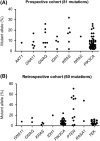Comprehensive molecular and clinicopathological analysis of vascular malformations: A study of 319 cases
- PMID: 30677207
- PMCID: PMC6594036
- DOI: 10.1002/gcc.22739
Comprehensive molecular and clinicopathological analysis of vascular malformations: A study of 319 cases
Abstract
Vascular malformations are part of overgrowth syndromes characterized by somatic mosaic mutations or rarely by germline mutations. Due to their similarities and diversity, clinicopathological classification can be challenging. A comprehensive targeted Next Generation Sequencing screen using Unique Molecular Identifiers with a technical sensitivity of 1% mutant alleles was performed for frequently mutated positions in ≥21 genes on 319 formalin-fixed paraffin-embedded samples. In 132 out of 319 cases pathogenic mosaic mutations were detected affecting genes previously linked to vascular malformations e.g. PIK3CA (n=80), TEK (TIE2) (n=11), AKT1 (n=1), GNAQ (n=7), GNA11 (n=4), IDH1 (n=3), KRAS (n=9), and NRAS (n=1). Six cases harbored a combination of mutations in PIK3CA and in GNA11 (n=2), GNAQ (n=2), or IDH1 (n=2). Aberrations in PTEN and RASA1 with a variant allele frequency approaching 50% suggestive of germline origin were identified in six out of 102 cases tested; four contained a potential second hit at a lower allele frequency. Ninety-one of the total 142 pathogenic mutations were present at a variant allele frequency <10% illustrating the importance of sensitive molecular analysis. Clinicopathological characteristics showed a broad spectrum and overlap when correlated with molecular data. Sensitive screening of recurrently mutated genes in vascular malformations may help to confirm the diagnosis and reveals potential therapeutic options with a significant contribution of PIK3CA/mTOR and RAS-MAPK pathway mutations. The co-existence of two activating pathogenic mutations in parallel pathways illustrates potential treatment challenges and underlines the importance of multigene testing. Detected germline mutations have major clinical impact.
Keywords: molecular genetics; mosaic mutations; overgrowth syndromes; vascular malformations.
© 2019 The Authors. Genes, Chromosomes & Cancer published by Wiley Periodicals, Inc.
Conflict of interest statement
Authors have no disclosures/conflict of interest.
Figures






Similar articles
-
Genotypes and phenotypes heterogeneity in PIK3CA-related overgrowth spectrum and overlapping conditions: 150 novel patients and systematic review of 1007 patients with PIK3CA pathogenetic variants.J Med Genet. 2023 Feb;60(2):163-173. doi: 10.1136/jmedgenet-2021-108093. Epub 2022 Mar 7. J Med Genet. 2023. PMID: 35256403
-
The genetics of vascular birthmarks.Clin Dermatol. 2022 Jul-Aug;40(4):313-321. doi: 10.1016/j.clindermatol.2022.02.006. Epub 2022 Feb 16. Clin Dermatol. 2022. PMID: 35181412 Review.
-
Somatic Activating PIK3CA Mutations Cause Venous Malformation.Am J Hum Genet. 2015 Dec 3;97(6):914-21. doi: 10.1016/j.ajhg.2015.11.011. Am J Hum Genet. 2015. PMID: 26637981 Free PMC article.
-
CD10 and CD34 as markers in vascular malformations with PIK3CA and TEK mutations.Hum Pathol. 2020 May;99:98-106. doi: 10.1016/j.humpath.2020.04.001. Epub 2020 Apr 6. Hum Pathol. 2020. PMID: 32272124
-
Genetic landscape of common venous malformations in the head and neck.J Vasc Surg Venous Lymphat Disord. 2021 Jul;9(4):1007-1016.e7. doi: 10.1016/j.jvsv.2020.11.016. Epub 2020 Nov 26. J Vasc Surg Venous Lymphat Disord. 2021. PMID: 33248299 Review.
Cited by
-
Improving genetic diagnostic yield in a large cohort of children with rare vascular anomalies or PIK3CA-related overgrowth spectrum.Genet Med Open. 2023 Oct 17;2:100837. doi: 10.1016/j.gimo.2023.100837. eCollection 2024. Genet Med Open. 2023. PMID: 39669602 Free PMC article.
-
Functional characterisation of a novel class of in-frame insertion variants of KRAS and HRAS.Sci Rep. 2019 Jun 3;9(1):8239. doi: 10.1038/s41598-019-44584-7. Sci Rep. 2019. PMID: 31160609 Free PMC article.
-
Extracranial Vascular Anomalies Driven by RAS/MAPK Variants: Spectrum and Genotype-Phenotype Correlations.J Am Heart Assoc. 2024 Apr 16;13(8):e033287. doi: 10.1161/JAHA.123.033287. Epub 2024 Apr 2. J Am Heart Assoc. 2024. PMID: 38563363 Free PMC article.
-
Mosaic KRAS Mutation in Schimmelpenning-Feuerstein-Mims Syndrome With Overlapping Oculoectodermal Syndrome and Encephalocraniocutaneous Lipomatosis Features.Pediatr Dermatol. 2025 May-Jun;42(3):591-595. doi: 10.1111/pde.15820. Epub 2024 Dec 7. Pediatr Dermatol. 2025. PMID: 39644163 Free PMC article.
-
When, where and which PIK3CA mutations are pathogenic in congenital disorders.Nat Cardiovasc Res. 2022 Aug;1(8):700-714. doi: 10.1038/s44161-022-00107-8. Epub 2022 Aug 8. Nat Cardiovasc Res. 2022. PMID: 39196083 Review.
References
-
- Blei F. Overgrowth syndromes with vascular anomalies. Curr Probl Pediatr Adolesc Health Care. 2015;45(4):118‐131. - PubMed
-
- Wassef M, Blei F, Adams D, et al. Vascular Anomalies Classification: Recommendations From the International Society for the Study of Vascular Anomalies. Pediatrics. 2015;136(1):e203‐e214. - PubMed
-
- Happle R. Mosaicism in human skin. Understanding the patterns and mechanisms. Arch Dermatol. 1993;129(11):1460‐1470. - PubMed
MeSH terms
Substances
LinkOut - more resources
Full Text Sources
Research Materials
Miscellaneous

